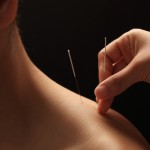
Cervical spine and shoulder pain are some of the most common pathologies treated by musculoskeletal therapists. Many patients with this type of pain will be suffering from active myofasical trigger point (MTrP) pain. These are localised hyper irritable spots within fascia that surround skeletal muscle.
Dry needling (use of acupuncture needles or hollow-core hypodermic needles for therapy of MTrPs) is a treatment that is widely used in clinical practice by physiotherapists, but how does it compare to other available treatments?
Here’s what they did
The authors searched the following 10 databases (English and Chinese) from inception to January 2014: PubMed, EBSCO, PEDro, ScienceDirect, The Cochrane Library, ClinicalKey, Wanfang Data Chinese database, China Knowledge Resource Integrated Database, Chinese Chongqing VIP Information and SpringerLink. Studies were included if they were a randomised controlled trial (RCT) that included patients with MTrPs associated with neck and shoulder pain, and used acupuncture or dry needling as an intervention. Furthermore, pain visual analogue scale or numerical rating scale had to be the outcome measure used. No language restriction was imposed during the search.
Review authors independently screened studies by inclusion/exclusion criteria, extracted data and assessed validity of the included studies using the PEDro scale. A third reviewer adjudicated when necessary.
Here’s what they found
Twenty RCT’s involving a total of 839 patients were identified and included in the 9 meta-analyses completed.
- Compared with control/sham, dry needling was effective in the short term (immediately to 3 days) (SMD = -1.91; -3.10 to -0.73 95% CI; p = 0.002) and medium term (9-28 days) (SMD = -.1.07; -1.87- to -0.27 95% CI ; p = 0.009;
- However, wet needling (e.g. local anaesthetic injection) was superior to dry needling in relieving MTrP pain in the medium term (SMD = 1.69; 0.40 to 2.98 95% CI; p = 0.01).
- The results for ‘other therapies’ (e.g, intramuscular stimulation, botox, physiotherapy) failed to reach enough statistical power to determine a significant change in pain when compared to dry needling.
- There were no statistically significant effects in the long term (2 to 6 months), however only a small number of studies looked at long term outcomes.
The authors concluded
Dry needling can be recommended for relieving MTrP in neck and shoulder in the short and medium term, but wet needling is found to be more effective than dry needling in relieving MTrP in neck and shoulders in the medium term.

Dry needling can be recommended for relieving MTrP in neck and shoulder in the short and medium term, but wet needling is found to be more effective in the medium term.
The Musculoskeletal Elf’s view

Firstly it is important to note that results should be treated with some caution as there was high heterogeneity between the trials, which is an inevitable effect when comparing trials with much clinical and methodological diversity. The authors tried to account for this in the statistical analysis.
When treating MTrP pain in the neck and/or shoulder pain, dry needling is a valid treatment option to use for short to medium term reduction in self reported pain. Wet needling is not a treatment modality used by physiotherapists and so the results for this are not directly applicable to our practice.
More research is needed to conclude about long term effects of dry needling for MTrP pain in the cervical spine and shoulders. In particular large-scale, multi-centred high quality RCTs with adequate follow up is recommended.
What do you think?
- What treatment modalities do you commonly use to treat active MTrPs?
- What are your experiences of using dry needling in clinical practice?
Send us your views on this blog and become part of the ever expanding Musculoskeletal Elf community. Post your comment below, or get in touch via social media (Facebook, Twitter, LinkedIn, Google+).
Links
Liu, L., Huang, Q. M., Liu, Q. G., Ye, G., Bo, C. Z., Chen, M. J., & Li, P. 2015, ‘Effectiveness of Dry Neeedling for Myofascial Trigger Points Associated with Neck and Shoulder Pain: A Systematic Review and Meta-analysis’ Archives of physical medicine and rehabilitation, Vol. 96, no.5, pp.944-955 [Abstract]

Effectiveness of dry needling Myofascial Trigger Points for neck and shoulder pain http://t.co/CZGBGBRpyU
Dry needling for neck and shoulder pain:
http://t.co/Too5TKjAOc
Is dry needling Myofascial Trigger Points effective for neck & shoulder pain? http://t.co/YlhCPLEYOO
How did any of the studies reliably ASSESS for ‘trigger points’? Could the fact trigger points appear to NOT reliably BE assessed contribute to the variability of results and lack of significant outcomes? How do we even know we are needling what we think we’re needling?
La punción seca es efectiva a corto y medio plazo, pero menos que la infiltración miofascial https://t.co/7qhVMjmeY6 @MSK_Elf
Hello, I am doing actually a PhD in the health science rehab department to compare DN with needle free injecting device on the market. Do you have experience in practice with those type of device versus the conventional acupuncture DN method ?
Thank you, have a great day
JP LAMB, DC, DO
jean-philippe.lamb@usherbrooke.ca
Wow. I was just googling my own name and found out about your work. It is very similar than the PhD I’ve started at University of Sherbrooke (comparing wet needling to wet needling administered with a needle free gun injector) for the treatment of Neck to shoulder MTrPTs. This doctoral program will never be terminates for many reasoons. Very happy that someone did the metanalysis. If you published something don’t hesitate to send it to me. Now I work as a clinician in a chronic non cancer pain Clinic near Montreal, Canada.